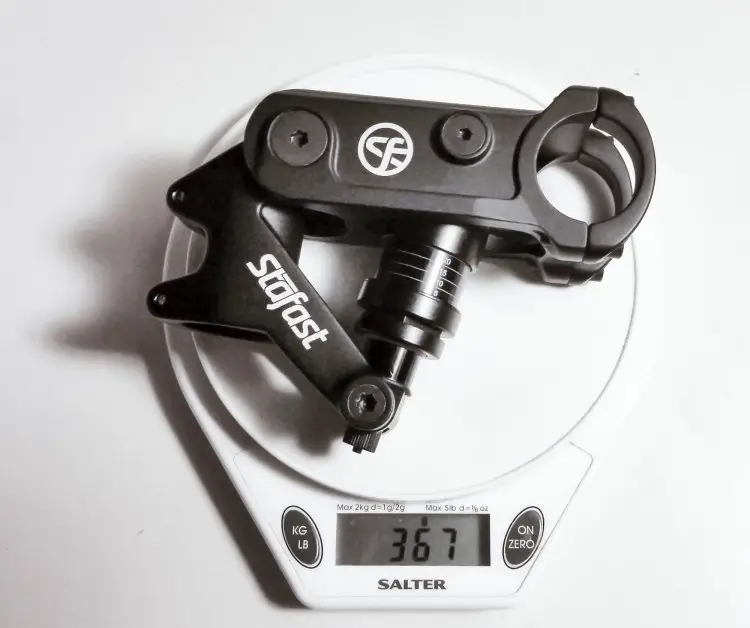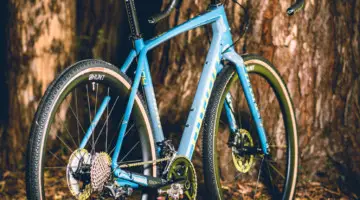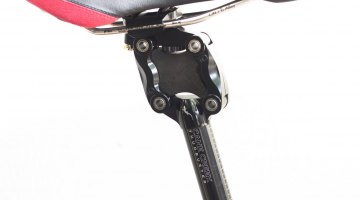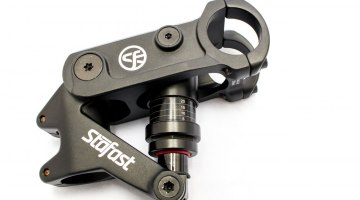The cycling industry has a “cycle” of innovation that surprises consumers by resurfacing and reinventing products that were popular years ago. Look at a high-end bicycle shop and you’ll see plenty of lace-up cycling shoes, wool jerseys, handmade cotton tires, cotton crochet gloves, small-diameter seatposts, and ovalized chainrings.
Bikes have gone full circle too. The new generation of gravel bikes tend to mimic the sport touring bikes of twenty and thirty years ago in terms of geometry and tire clearance. Cannondale has embraced drop bar suspension bikes again after introducing the Headshok-equipped cyclocross bikes 15 years ago, and has even embraced 25.4mm seat posts.
Stafast, a Michigan-based company started by engineers Sam Kovalak and Charlie Brickey, hopes that the suspension stem will be the next innovation that is ready for refinement and reintroduction.
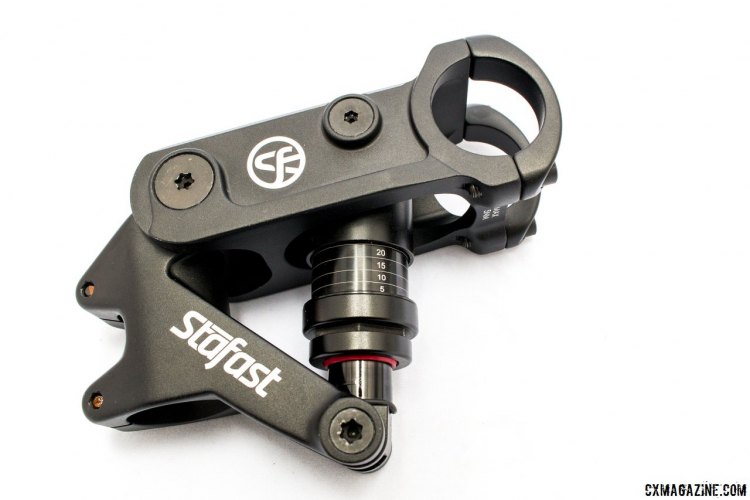
Suspension stems are back, with air dampened shocks and angle adjustment. Stafast air shock suspension stem. © Cyclocross Magazine
An Idea’s Time Has Come…Back?
Old timers will remember suspension stems from the ’90s from Softride, Girvin and others. Like any new product, they weren’t perfect, but were a viable, lightweight and simple alternative to the early generation of suspension forks that were unrefined to say the least. And for three years in a row, starting in 1992 in Bromont Canada, through 1994 in Vail, Colorado, Softride’s suspension stem, as piloted by Danish mountain bike and cyclocross star Henrik Djernis, beat every suspension fork-equipped racer (including Ned Overend and John Tomac) at the Mountain Bike World Championships.
Companies big and small are now looking for creative ways to take the edge off a ride. We’ve ridden compliant posts from Specialized, Ergon and Cirrus, and tested bikes from Calfee and Trek that all attempt to address mostly rear-wheel bumps. But as two decades of cross country mountain bike development have proven, it’s more important to suspend the front of the bike to navigate bumpy terrain safely and quickly.

Suspension stems have transformed, and the Stafast air shock suspension stem is ready to leap into action on one of our test bikes. © Cyclocross Magazine
While larger wheels and tires and better suspension forks and full suspension frames now dominate the mountain bike scene, cyclocross and gravel races are still typically tackled on fully rigid machines. Yet during gravel races, especially rougher ones up in the mountains like the Lost and Found, racers can take quite a beating, and unexpected rocks and bumps can throw even great bike handlers off their bikes.
Does the popularity of gravel racing mean there’s a new market for the simple, lightweight suspension found on suspension stems?
Stafast Adds Adjustable Air Shock, Positioning
The Stafast takes a different approach to the suspension stems than the decades-old designs we’ve seen in the past. The biggest change is that the stem doesn’t rely on an elastomer or metal spring, but instead uses an air shock/dampener that is highly adjustable by the included shock pump. Recommended pressure ranges from 0 to 275 psi, which allows racers to highly tune the dampening and rebound of the stem.
The shock has about 1 cm of travel, maximum, but don’t make the mistake thinking that’s a minuscule amount you won’t feel. The shock is attached to the stem about 3/5ths down the length of the stem, so the travel at the handlebar clamp is almost double, and at your hoods, would be even more. Stay tuned as we attempt to measure it on our 95mm test stem, but we estimate that the hoods of a drop handlebar will move more than an inch. (It’s also worth noting that the handlebar also rotates during the stem’s travel, unlike the straight-line movement seen on the old, complex parallelogram-based design of the Softride).
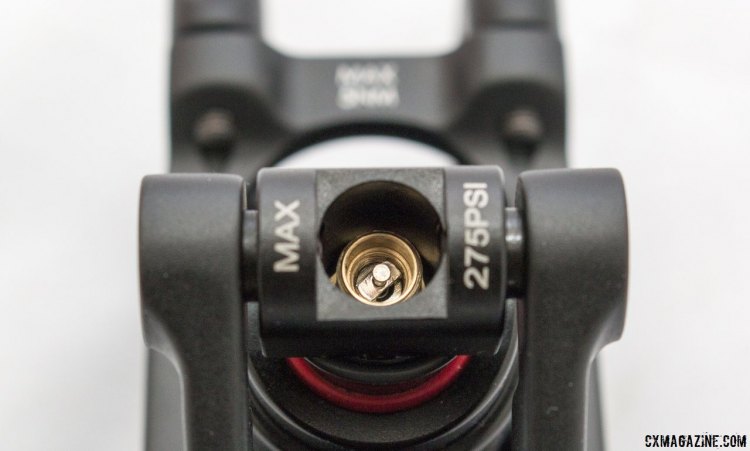
Air pressure is handled with the included Schrader valve shock pump. Max 275 psi. Stafast air shock suspension stem. © Cyclocross Magazine
Beyond the adjustable air shock, the Stafast stem offers a 25 degree range of adjustment in height, without the use of steer tube spacers or need to adjust the headset or top cap bolt. The 25 degrees translates into about 1.25″ of handlebar height adjustment. This could be convenient if you do vastly different types of rides on one bike (or if you are a fitter looking to easily dial in handlebar height). The angle can be adjusted by an included wrench.

The angle adjustment lets you customize the fit for different events. Stafast air shock suspension stem. © Cyclocross Magazine
Lightweight, Affordable Suspension or a Heavy Stem?
Our 95mm test model weighed 367 grams. That’s a bit over 200 grams more than an average threadless stem. Two hundred grams may sound like quite a bit, and if you’re picking up your bike to throw it on your shoulder, or pick it up over the barriers, you’ll notice the weight. But let’s put that in context.
Take the new Cannondale Slate or a Lefty-equipped cyclocross bike we tested at NBX. You can be sure that the Lefty suspension fork adds 800 grams over a rigid carbon fork. Kindshock has long made short-travel suspension forks for 700c bikes, and its carbon fork options start at around 1200g, also nearly 800g heavier than carbon cyclocross forks.
Change out your “normal” 32c cyclocross tires for the comfort of 40c gravel tires? You could easily add 200g per tire, if you were to select our Editor’s Choice WTB TCS (Tubeless) Nano 40c tires. So compared to a few other alternatives to add some cush to the front of your bike? The Stafast stem looks like a reasonably light option.
At $350, it’s also a pretty affordable way to add some suspension and adjustability to your existing bike, compared to lining up for a new ride.
More Control, Less Fatigue = Stay Fast?
We’re most interested in seeing if the stem will be a welcomed addition on longer, rougher mixed-terrain adventures and gravel rides, but you can be sure we’ll also be looking to see if it will make us faster on the dry, bumpy cyclocross courses that we often find in this drought-stricken state. Judging by this video, the company seems to think the stem will work well on mixed terrain riding. Stay tuned as we put the Stafast stem through a full test.
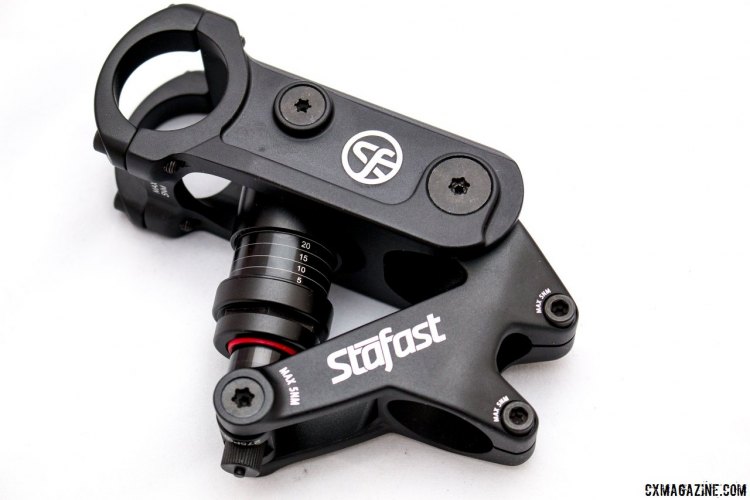
Stafast air shock suspension stem offers angle adjustment and air-dampened travel. © Cyclocross Magazine
Stafast Stem Specs:
MSRP: $350
Lengths: 95mm, 105mm
Weight: 366 grams (350g list, 95mm)
Bar Clamp: 31.8mm
Steerer Clamp: 1-1/8″
Shock: Air, 0-275 psi, Schrader valve
Included: Shock pump, Custom top cap, Angle adjustment wrench
More info: sta-fast.com and on youtube.com













